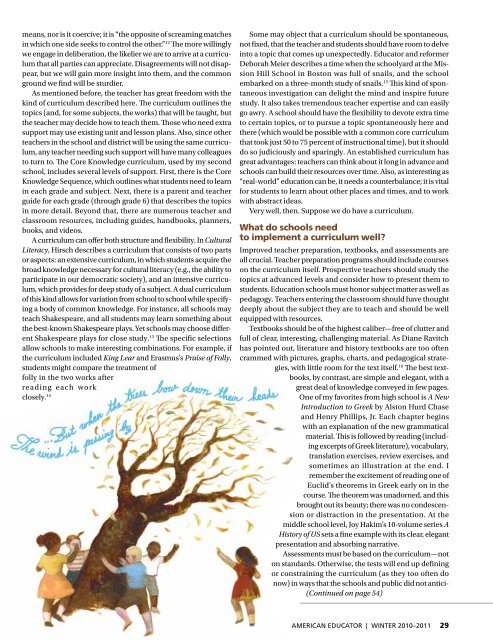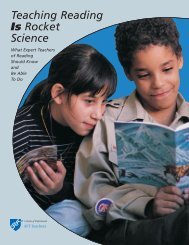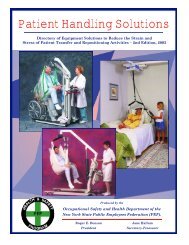American Educator, Winter 2010-11, Vol. 34, No. 4, AFT
American Educator, Winter 2010-11, Vol. 34, No. 4, AFT
American Educator, Winter 2010-11, Vol. 34, No. 4, AFT
Create successful ePaper yourself
Turn your PDF publications into a flip-book with our unique Google optimized e-Paper software.
means, nor is it coercive; it is “the opposite of screaming matches<br />
in which one side seeks to control the other.” 12 The more willingly<br />
we engage in deliberation, the likelier we are to arrive at a curriculum<br />
that all parties can appreciate. Disagreements will not disappear,<br />
but we will gain more insight into them, and the common<br />
ground we find will be sturdier.<br />
As mentioned before, the teacher has great freedom with the<br />
kind of curriculum described here. The curriculum outlines the<br />
topics (and, for some subjects, the works) that will be taught, but<br />
the teacher may decide how to teach them. Those who need extra<br />
support may use existing unit and lesson plans. Also, since other<br />
teachers in the school and district will be using the same curriculum,<br />
any teacher needing such support will have many colleagues<br />
to turn to. The Core Knowledge curriculum, used by my second<br />
school, includes several levels of support. First, there is the Core<br />
Knowledge Sequence, which outlines what students need to learn<br />
in each grade and subject. Next, there is a parent and teacher<br />
guide for each grade (through grade 6) that describes the topics<br />
in more detail. Beyond that, there are numerous teacher and<br />
classroom resources, including guides, handbooks, planners,<br />
books, and videos.<br />
A curriculum can offer both structure and flexibility. In Cultural<br />
Literacy, Hirsch describes a curriculum that consists of two parts<br />
or aspects: an extensive curriculum, in which students acquire the<br />
broad knowledge necessary for cultural literacy (e.g., the ability to<br />
participate in our democratic society), and an intensive curriculum,<br />
which provides for deep study of a subject. A dual curriculum<br />
of this kind allows for variation from school to school while specifying<br />
a body of common knowledge. For instance, all schools may<br />
teach Shakespeare, and all students may learn something about<br />
the best-known Shakespeare plays. Yet schools may choose different<br />
Shakespeare plays for close study. 13 The specific selections<br />
allow schools to make interesting combinations. For example, if<br />
the curriculum included King Lear and Erasmus’s Praise of Folly,<br />
students might compare the treatment of<br />
folly in the two works after<br />
reading each work<br />
closely. 14<br />
Some may object that a curriculum should be spontaneous,<br />
not fixed, that the teacher and students should have room to delve<br />
into a topic that comes up unexpectedly. <strong>Educator</strong> and reformer<br />
Deborah Meier describes a time when the schoolyard at the Mission<br />
Hill School in Boston was full of snails, and the school<br />
embarked on a three-month study of snails. 15 This kind of spontaneous<br />
investigation can delight the mind and inspire future<br />
study. It also takes tremendous teacher expertise and can easily<br />
go awry. A school should have the flexibility to devote extra time<br />
to certain topics, or to pursue a topic spontaneously here and<br />
there (which would be possible with a common core curriculum<br />
that took just 50 to 75 percent of instructional time), but it should<br />
do so judiciously and sparingly. An established curriculum has<br />
great advantages: teachers can think about it long in advance and<br />
schools can build their resources over time. Also, as interesting as<br />
“real-world” education can be, it needs a counterbalance; it is vital<br />
for students to learn about other places and times, and to work<br />
with abstract ideas.<br />
Very well, then. Suppose we do have a curriculum.<br />
What do schools need<br />
to implement a curriculum well?<br />
Improved teacher preparation, textbooks, and assessments are<br />
all crucial. Teacher preparation programs should include courses<br />
on the curriculum itself. Prospective teachers should study the<br />
topics at advanced levels and consider how to present them to<br />
students. Education schools must honor subject matter as well as<br />
pedagogy. Teachers entering the classroom should have thought<br />
deeply about the subject they are to teach and should be well<br />
equipped with resources.<br />
Textbooks should be of the highest caliber—free of clutter and<br />
full of clear, interesting, challenging material. As Diane Ravitch<br />
has pointed out, literature and history textbooks are too often<br />
crammed with pictures, graphs, charts, and pedagogical strategies,<br />
with little room for the text itself. 16 The best textbooks,<br />
by contrast, are simple and elegant, with a<br />
great deal of knowledge conveyed in few pages.<br />
One of my favorites from high school is A New<br />
Introduction to Greek by Alston Hurd Chase<br />
and Henry Phillips, Jr. Each chapter begins<br />
with an explanation of the new grammatical<br />
material. This is followed by reading (including<br />
excerpts of Greek literature), vocabulary,<br />
translation exercises, review exercises, and<br />
sometimes an illustration at the end. I<br />
remember the excitement of reading one of<br />
Euclid’s theorems in Greek early on in the<br />
course. The theorem was unadorned, and this<br />
brought out its beauty; there was no condescension<br />
or distraction in the presentation. At the<br />
middle school level, Joy Hakim’s 10-volume series A<br />
History of US sets a fine example with its clear, elegant<br />
presentation and absorbing narrative.<br />
Assessments must be based on the curriculum—not<br />
on standards. Otherwise, the tests will end up defining<br />
or constraining the curriculum (as they too often do<br />
now) in ways that the schools and public did not antici-<br />
(Continued on page 54)<br />
AMERICAN EDUCATOR | WINTER <strong>2010</strong>–20<strong>11</strong> 29





